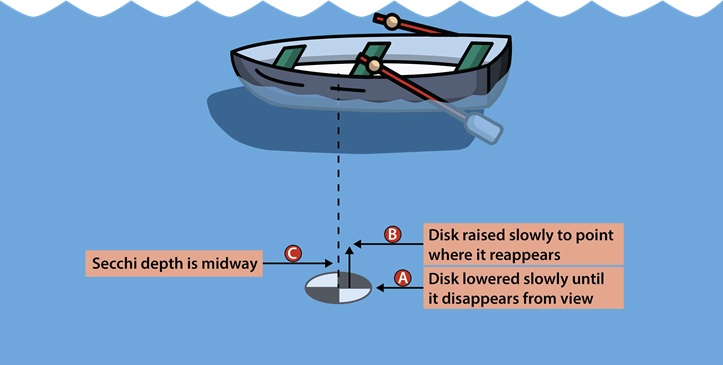Level 3 study procedures and documents
Reminder
Do not go out if:
- It's raining heavily (making it difficult to see the Secchi disk accurately)
- There's abnormally high boat traffic, or
- Your safety would be at risk
A clear, calm day is best.
Refer to the Level 3 program overview page for useful information before and after your sampling event.
Step 1: Getting to the site
- Upon arrival, note any safety hazards or concerns and adjust plans as needed
- It's important that the exact location of the predetermined station is found so that the measurements collected can be compared with the water quality data collected by the ministry
- It's recommended to use a GPS or depth sounder
- Before anchoring, check the lake depth with calibrated rope/tape or depth sounder:
- Record the depth to the nearest 0.01 m or establish a permanent buoy. This will allow "bottom-1 m" sample to be collected at correct depth relative to the bottom
- If dropping an anchor, allow boat to swing away from the bottom sediment disturbance caused by dropping anchor
- If very calm, anchoring may not be necessary
- Record the date, time, volunteer names, weather, and water conditions

Step 2: Lake profile

- Calibrate the YSI
- Refer to How to Calibrate My YSI ProSolo ODO Meter for step-by-step instructions:
- To get accurate readings the meter depends on Barometric pressure, which varies daily, so the meter must be calibrated each time you sample
- Record the Post Cal Value % DO reading and the Barometer reading at the end of calibration in the field sheet to help us determine whether the YSI probe needs servicing
- Lower the YSI probe until the probe is submerged just below the surface
- Wait at least one minute before reading your results to allow the readings stabilize
- Record:
- Temperature (to the nearest 0.01°C)
- Dissolved oxygen (to the nearest 0.01 mg/L)
- Lower the YSI probe until the sensor is submerged just below the surface of the water (the '0 m' reading)
- Continue to measure and record temperature and dissolved oxygen values at one metre intervals, until you reach a depth of 20 metres. After 20 metres, measure and record at 5 metre intervals. The last measurement will be from a depth one metre above the measured lake bottom (to prevent sediments getting into the sensor) or until the probe cable has reached its maximum length. You may have to alter the final depth on your field sheet to include the depth 1 m off the bottom
Step 3: Water sampling
- For water collection from any depth:
- Set sampler, ensuring misfire will not occur
- Lower to desired depth, sway rope to exchange water in sample
- Drop messenger, and
- Retrieve sampler
- Using valve/hose on sampler, carefully fill sample bottles allowing contents to overflow (forcing bubbles out):
- Remove caps just prior to sampling and protect from contamination
- Do not touch the insides of the bottles or caps with fingers or sampler hose
- If you suspect that a bottle or cap has been contaminated, rinse it thoroughly with sample water and make a note on the field sheet
- Refer to the bottle guide for more detailed information
For each regular sample, record any water odour or colour observations on the field sheet:
- Odour: Smell water in sampler for odour
- Example descriptors: Nil (no odour), organic, sulphur (rotten eggs), metallic, etc.
- Water colour: Observe water colour in sampler preferably against a white backdrop
- Example descriptors: Clear, green, brown, cloudy, etc.
Step 4: Secchi depth
- Remove any hats and sunglasses, as these will interfere with your measurement
- Lower the Secchi disk over the shaded side of the boat
- Slowly lower the disk until the black and white pattern is no longer visible. Note the measurement on the tape measure (in metres) at the surface of the water (estimate to the nearest 0.01 m). Record this as Distance A
- Pull the disk up until the black and white pattern just appears again and note the measurement of the tape measure at surface of the water. Record this distance as Distance B
- Average the 2 measurements [(Distance A + Distance B)/2] = Secchi depth

Step 5: Check and fill in the remainder of the form
Fill in the entire form and note any observations while travelling to or while sampling at the site.
This may include:
- Algal blooms
- Surface slicks
- Debris
- Pollen
- Zooplankton
- Fish kills
- Recent storm or high wind events
- Fishing derbys
- Water skiing competitions, etc.
The data form has space for one site on the same water body.
If you need more, use a separate copy of the data form.
Step 6: Shipping
- Ensure water samples remain cool (ideally 4°C) until ready for shipping (use ice packs provided)
- Take a photo of the completed requisition form as a backup
- Place completed requisition form in zip loc bag and put in cooler
- Ship cooler containing bottles, ice, and requisition form to the lab within 24 hours of sampling:
- The lab results can be affected by warm samples and time between collection and analysis

Step 7: Data entry and end of season responsibilities
- Preferably, use our Field Data Submission Tool to submit your field data after each sampling event
- Make sure to attach photos of the completed lab requisition and any field observations
- Using the Purolator account number provided, return sampling equipment to the ministry for maintenance and storage within 30 days of final sampling event for the season, unless otherwise arranged
- Phone: 250-649-2939
- Ministry of Environment and Parks
Attn: BC Lakes Stewardship and Monitoring Program
1011-4th Ave, Suite 325
Prince George, B.C.
V2L 3H9
Contact us if you need assistance with any of the above steps.
Field data submissions
For current lake monitoring volunteers, send us your completed field data:
Current volunteers
Other field procedures:
Additional resources:
Level 3 study procedures and documents
Contact information
If you have questions:
- Contact the aquatic stewardship coordinator
